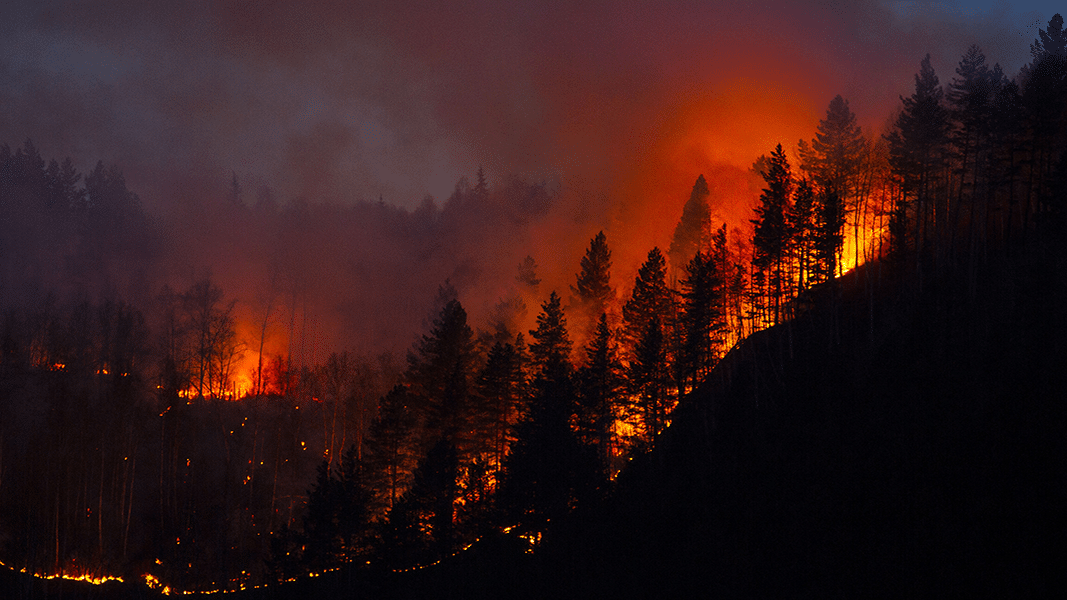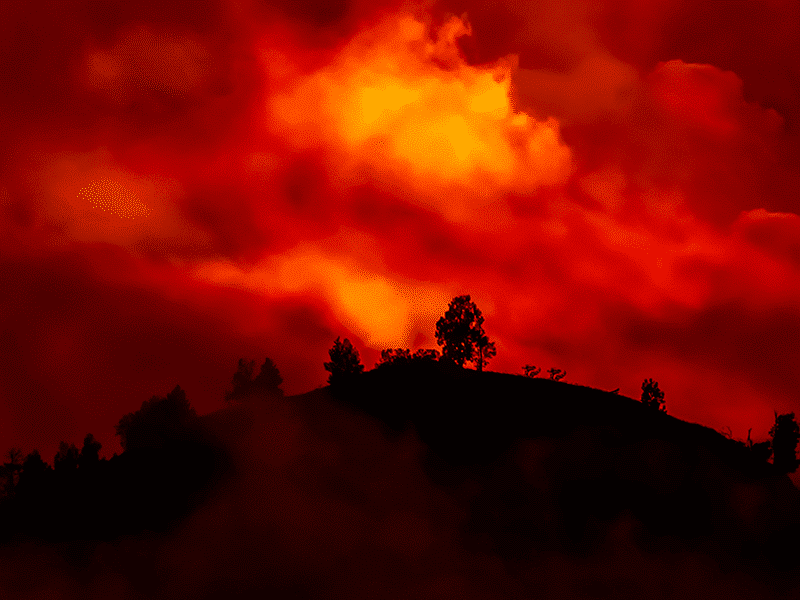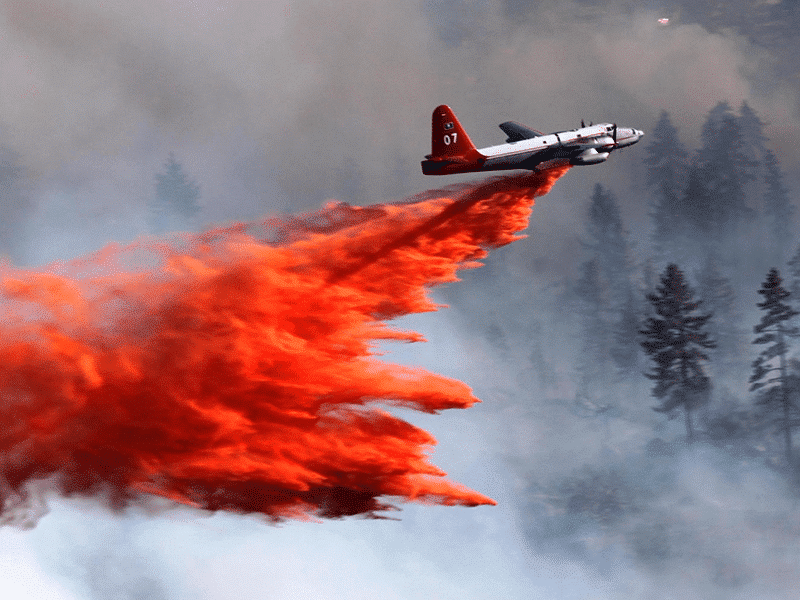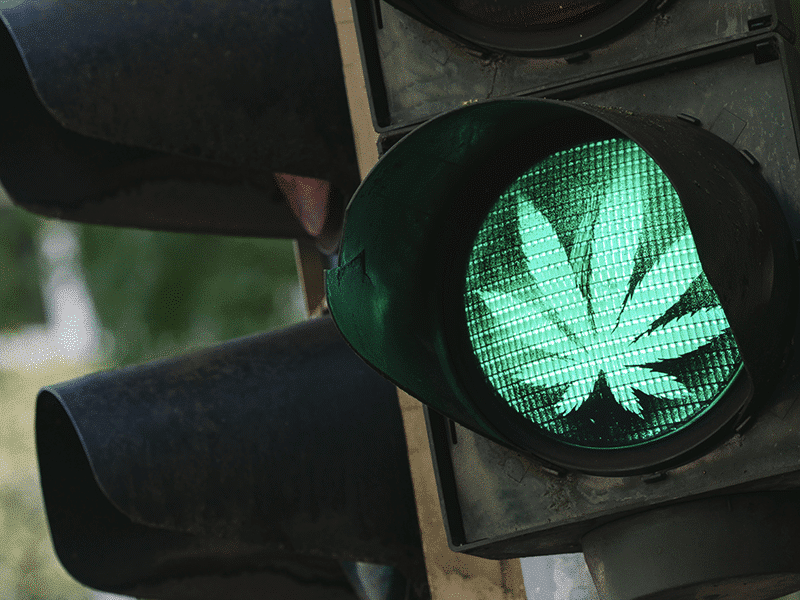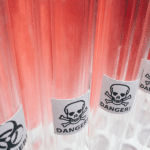The year 2020’s record-breaking wildfires in California and other Western states have compounded the dire impacts of the COVID-19 pandemic — and have similarly been politicized. Thus far, the blow they have dealt to the cannabis industry has been well weathered. But annual firestorms will pose a growing challenge for years to come — especially given that those regions of the US where legal cannabis cultivation is most advanced are also the most vulnerable to this devastating manifestation of ecological disequilibrium.
With fires emerging in early summer and now extending into December, authorities are having to rethink the notion of a discrete “fire season” in California. The total acreage burned across the state in 2020 exceeded 4 million, according to the CalFire tracking page — more than any year since record-keeping began in the 1932. Among several major fire systems statewide, the August Complex, centering on the Emerald Triangle counties of Mendocino and Trinity, passed the one-million-acre mark, prompting coinage of an entirely new term: “gigafire.”
“Unprecedented”
From its monitoring instruments on the International Space Station, NASA determined that particulate matter from the 2020 fires was actually dispersing through the stratosphere, a previously unknown phenomenon with still unknown impacts on global climate.

Some 35 lives were lost across the West Coast, and in mid-September the skies above the heavily urban San Francisco Bay Area turned an eerie orange.
Air pollution levels were at historic highs, raising especially grim questions amid the COVID-19 pandemic, such as whether the poor air could worsen respiratory woes associated with the disease.
Questions were raised about a near-future inhabitability of the Golden State. Writer Bill McKibben asked, “Has the climate crisis made California too dangerous to live in?”
2020 also saw record-breaking wildfires in Colorado, while the fires that ravaged Oregon were termed “unprecedented” by Gov. Kate Brown.
All three states have seen a burgeoning legal cannabis industry take hold in recent years. What does the changing climate in these states portend for that industry’s future prosperity — or, perhaps, survival?
Wine, Weed & Smoke
Thus far, media attention has focused on another mainstay mood-altering substance with a connoisseur clientele — California’s wine industry. The devastating Glass Fire damaged, if not destroyed, nearly 30 wineries in Napa and Sonoma counties.
But outright crop loss was far from the only problem. The foodie website Civil Eats warned: “In grapes, smoke damage imparts a burnt, ashy, even medicinal taste to the resulting wine. When wood burns, it releases volatile compounds called phenols, which can bind to grape sugars, only to be released during fermentation.” And the account added: “Cannabis may also be similarly impacted by volatile compounds, and possibly other chemicals if buildings — and not just wildlands — burned nearby.”
John Aguirre, president of the California Association of Winegrape Growers, told the agriculture trade journal Capital Press that high-end wineries are reluctant to produce from grapes exposed to smoke. Aguirre estimated the 2020 wildfires resulted in up to $500 million in crop losses statewide just from canceled or reduced grape contracts. California wine grapes are worth $4 billion annually “at the farm gate,” with Oregon and Washington clocking in at about $597 million combined. “Obviously, we can’t sustain these types of losses going forward and continue doing what we do,” Aguirre said.
Cannabis is also a product that is prized for flavor, and the cannabis industry has emulated viniculture in cultivating a cachet of terroir. But how the fires impacted cannabis (with a legal sector exceeding $3 billion in sales in 2019) has received less attention.
The University of California’s Berkeley Cannabis Research Center (BCRC) is undertaking a study of the question. With a grant from the state Bureau of Cannabis Control, the BCRC is preparing to interview growers across California about their experiences amid the devastation — crop losses or damage, impacts on sales, mitigation techniques. The pending study, Cannabis & Wildfire Risk: Current Conditions, Future Threats & Solutions for Farmers, will be released by the end of 2021, and will include a policy brief especially aimed at counties and localities.
Was the 2020 Harvest Damaged?
BCRC environmental science researcher Christopher Dillis is direct about the daunting reality. “2019 was a record-setter and 2020 beat that,” he tells Project CBD. “Hopefully 2021 won’t beat that again.”
The good news from preliminary surveys is that direct crop loss was “miniscule,” Dillis says. “The number of cannabis farms that burned in the state is below five percent of the total. Smoke damage is really what we’re talking about.”
Dillis sees one possible unanticipated outcome of the fires for the legal industry as a “competitive asymmetry with the unpermitted market.” Illicit-market cannabis, of course, does not have to pass muster with the California Department of Food & Agriculture. “Smoke-damaged weed may still be sellable on the unpermitted market even though it may not meet standards for the regulated industry. And the new regulated industry is already having a hard time competing with an unpermitted market that is untaxed and not subject to regulation.”
And he notes the irony that the area most impacted by the fires corresponds to the legacy cannabis heartland of the Emerald Triangle, where small producers still predominate. Comparatively unscathed were Santa Barbara and the Central Valley’s Yolo County, where the practice of “license stacking” has allowed cannabis “megafarms” to emerge in spite of official limits on the size of licensed plots.
Dillis acknowledges that smoke damage to cannabis crops could be difficult to measure. “I haven’t heard anything about testing failures from wildfire smoke,” he says. “But that could be because the growers are not bothering to submit because they know the harvest is unpalatable.”
Laboratory Findings
Robert Martin, CEO of CW Analytical cannabis testing laboratory in Oakland, says that so far the worst fears of growers have not been realized.
“One grower in Mendocino had inches of ash on his crop, and it didn’t show a lot of what we usually test for,” Martin tells Project CBD. “We have had some complaints about off-flavor, but we didn’t find any toxic compounds, so he was able to sell his product just fine. We were really surprised. We were mostly catching carbonate,” which is not a health risk in the quantities involved, he says. “The bigger impact was actual burning of fields. About 10% of our clients in Mendocino lost their crops to the fires.”
As far as flower quality goes, Martin raises concern about creosote, the phenol-rich wood-tar that was the main culprit in degrading the quality of the grape harvest. But this is mostly an aesthetic question rather than a health one. “We didn’t test for creosote because there’s no state standard for it,” Martin says. “We didn’t see any other compounds, so we assume it was mostly creosote. We were expecting arsenic, lead, cesium, mercury, iron. But we didn’t see anything in dangerous levels.”
These compounds are far more prevalent in human structures than trees. Thus dangerous heavy metals, such as arsenic and lead, are more likely to be in smoke from fires in urban areas. But only a small percentage of the crop CW Analytical tested was actually rejected, Martin says, while a larger percentage of his clients’ crop was lost to fire than ever before. And cannabis farmers can’t get federal crop insurance.
Martin notes that one unforeseen result of the fires was caterpillar infestations. “Caterpillars attacked cannabis this year due to smoke driving away moths from forest into agricultural areas. They laid their eggs in flowers, and we saw infestation like we’d never seen before — hundreds on a plant.” And this wasn’t just seen in the Emerald Triangle but also in the Central Valley. “A moth can travel a hundred miles if it wants to. Just like wildcats and other wildlife are entering suburban neighborhoods due to the fires — same principle.”
And there were other impacts. “A lot of agriculture aspects were affected by the smoke,” Martin says, citing reports from CW’s clients. “Plants didn’t mature well and lost their aroma due to ash. The more aromatic a cannabis flower, the more it’s valued by the consumer. So those producing for the specialty flower market were hit the hardest. A lot of the harvest will probably be used to make concentrates and oils, where flavor isn’t that important.”
He also notes that indoor growers were not affected, which could give a boost to that sector of the industry.
A Windfall for Remediation?
Jill Ellsworth is founder and chief executive officer of Willow Industries, a Colorado-based company that specializes in cannabis remediation and decontamination. The company’s patented Willowpure system treats finished flower that has been cured and trimmed. The device’s chamber infuses with ozone gas that oxidizes mold, bacteria, yeast “or anything that could be pathogenic for human consumption and would not pass state testing,” she explains.
Ellsworth says the process does not disrupt potency or terpene levels. Flower that fails initial testing must pass a second screening after the treatment. She emphasizes her company’s strict adherence to safety standards: “Ozone is a dangerous gas, so we take necessary measures to assure safety.”
Willow Industries has been conducting on-site cleaning at grow-ops in Colorado since 2015, and four years later it opened a facility in Oakland. “We’re definitely hearing from clients around California of plants impacted by smoke,” she says. “We’re getting flower affected with a smoky flavor. Ozone is typically used to get rid of unpleasant smells, so we are in the middle of research and development now to see if we can get rid of the smoky taste.”
And there’s an urgency to this R&D, according to Ellsworth. “Growers can’t sit on their harvest.” She says the remediation method is being tested free of charge on a 70-pound batch from Southern Humboldt. “We’ll see how that goes and maybe do the client’s entire harvest.”
It seems that the 2020 Colorado fires haven’t had much impact on the harvest in the Centennial State. The “weedbasket” of commercial outdoor cultivation has emerged in the county of Pueblo, on the edge of the Great Plains and well to the east of the forested Rocky Mountain areas that were badly hit by the blazes. But there are also small outdoor farms scattered throughout the Rockies in Colorado. “There, we thought it might be an issue. But so far, no,” says Ellsworth.
She also notes widespread reports from California growers of early flowering this year due to sunlight being blocked by smoke. This cut short the critical vegetative stage of growth – which can mean reduced yields.
The cannabis community has been grappling with the issue of possible hazards from smoke-damaged flower at least since the California fires of 2017. It’s important to note that cannabis smoke — even from untainted, organic plants — also contains carcinogens. However, smoking cannabis has not been linked to increased risk of lung cancer, possibly because THC, CBD and other plant cannabinoids have anti-carcinogenic properties.
Oregon Hemp: Damage Assessment Pending
Researchers at Oregon State University are convening a new working group to study the effects of wildfire smoke on the 2020 hemp crop in the impacted states. Jeffrey Steiner, associate director of OSU’s Global Hemp Innovation Center (GHIC), told Project CBD: “There’s a lot of concern here on the West Coast as to the effects of smoke compounds on hemp crop quality and safety. We rapidly pulled together a cross-section of sectors in the hemp industry, from production to processing to testing laboratories, to get a pulse of what problems they might be experiencing.”
The GHIC was just founded last year — right on time to address the fire crisis, even if that wasn’t the intention. “We’re here as a land-grant institution, trying to see what we can do to help farmers know better how to produce and process and move their crops along,” says Steiner. “Then the fires hit. How can we rapidly respond to help farmers be successful even in a bad year like this?”
A part of this work will be monitoring test results on hemp flower (non-euphoric cannabis) intended for CBD extraction, to get a handle on the contamination question. “We know growers in Oregon, California, and Washington have been washing ash off crop. Are elevated heavy metals being deposited by the ash? A lot of the harvest is still off at laboratories being analyzed. Results over the next weeks will help establish what we should be looking for in the future.”
Steiner again notes the analogy to viniculture — but stresses its limits. “For the last 10 years, compounds in smoke have been affecting the quality of wine grapes. Flavor-changing compounds can end up in the wine. But with hemp, there’s no fermentation going on, and no acid conditions. The compounds are not interacting with grape juice. And here in Oregon, nearly all of the hemp crop is for essential oils with compounds such as CBD. So flavor is not so important.”
Hemp farming was already depressed in Oregon before the firestorms hit. “In 2020, only about 20 percent of acreage was under cultivation compared to last year, due to overproduction,” says Steiner, who also sees a likely impact on yields. “The crop in Oregon probably didn’t grow as fast due to overcast conditions from the fires, which caused temperatures to drop up to 10 degrees in September.”
Defiant Growers Resist Evacuation
The fires placed growers in a quandary when mandatory evacuation orders were issued. Many in the Emerald Triangle opted for defiance.
Inside Climate News took an uncharacteristic look at cannabis, noting that “climate change-fueled weather disasters” have ironically displaced law enforcement as the biggest threat California cultivators face since legalization.
The report noted the dilemma that cannabis-based communities faced when the August Complex swept through the Triangle. “In tiny towns shrouded by forests, pot growers have stared down evacuation orders as if they were bar room dares. Despite warnings that firefighters would not risk their lives for people who refused to leave when ordered, most growers, law enforcement officials said, stayed to defend their crops from fire and thieves.”
The Los Angeles Times reported from Trinity Pines, a backwoods community in Trinity County that is home to some 40 legal farms, with more than 10 times that number of illicit grows hidden in the bush. Growers there overwhelmingly chose to face down death rather than leave their precious plots to fate. Among the holdouts were numerous Hmong families, originally from Laos, who have moved to the area in recent years, attracted by the cannabis economy.
Seng Alex Vang, a member of the Hmong community in the Central Valley and a lecturer in ethnic studies at California State University-Stanislaus, said of the Hmong growers: “I believe a lot of them put their life savings into this marijuana grow.” If their farms were consumed by the flames, “it’s a total loss.”
For illicit growers in the community, mistrust of authorities, and perhaps confusion as to the distinction between law enforcement and firefighters, may have contributed to a determination that they were better off handling the situation themselves.
Next – Part II: Fighting Fire with Fire
Bill Weinberg, a Project CBD contributing writer, is a 30-year veteran journalist in the fields of drug policy, ecology and indigenous peoples. He is a former news editor at High Times magazine and produces the websites CounterVortex.org and Global Ganja Report. © Copyright, Project CBD. May not be reprinted without permission.
Recommended Readings
Fighting Fire with Fire
Part two of a 2-part series on cannabis, climate change, and the California wildfires.
Fire, Brimstone & Dioxin
Heavy smoke has blanketed the skies in the Bay Area, threatening cannabis crops and public health.
Green Rush Blues: California Cannabis After Legalization
Part 1 of our 3-part series: Eco-Crisis: Will Legalization Save California’s Forests?

